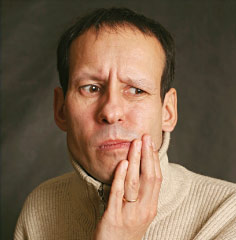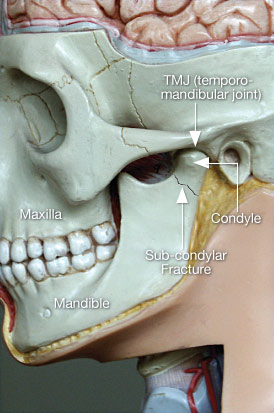Jaw Pain — What's the Cause?
You'll never know without a proper evaluation
Dear Doctor,
A week ago I was horsing around with my brother when I fell on the right side of my chin. It didn't seem so bad at the time and the emergency room sent me home. My left jaw joint still really hurts, I can barely move my jaw and I can't quite seem to get my teeth to fit together. What should I do?

Dear Jeremy,
Well, first off you really should see your dentist without delay. He/she will need to do a proper examination in order to access the situation directly. If necessary he/she will then send you to an oral and maxillofacial surgeon (a dentist who specializes in the diagnosis and treatment of disorders and diseases of the jaws), to make a more definitive determination or what we call diagnosis, which in turn will allow for proper treatment. If your symptoms are not going away, don't delay because you don't want to do irreversible damage.
It's not possible to know the exact extent of your injury without examination, but here are a few general pointers:
The most likely possibilities are that:
- You displaced a tooth or teeth that are causing the problem.
- You indirectly traumatized or injured the jaw joint (TMJ – temporo-mandibular joint). This trauma will cause swelling in the joint space and the ball or head of the joint known as the “condyle” will not fully seat into the joint space. If this is the case it is likely that your back teeth on that side will not touch. Over time, about one week, the swelling should subside and the teeth will fit together normally.
- You may indeed have a minor fracture of your lower jaw. The most common is a “sub-condylar” fracture (just below the head of the joint) which will persist in symptoms and are usually more severe than just bruising described above.
- You may also have dislocated or “subluxed” the joint in which case the condyle or joint head has been moved out of the joint space.
 |
| An illustration of the lower half of a person's head, identifying the maxilla, the mandible and the TMJ (temporo-mandibular joint). Also identified is where the TMJ injury occurs and where the sub-condylar fracture is commonly located. |
All these injuries can cause muscle spasm, which means that as a result of the inflammation due to the injury, the muscles on either side of the jaw lock the jaw in position stopping further movement and damage. They act like nature's splint to immobilize the jaw.
In any event, a physical examination checking to see if everything is functioning normally, along with a radiological (x-ray) examination will reveal the extent of the injury, whether it's soft tissue and/or boney.
Minimally, anti-inflammatory and muscle relaxant medication would be helpful. Treatment of damaged teeth can be taken care of by your dentist. If the jaw is dislocated, immediate inability to close the jaw will be evident, in which case it may need gentle manipulation to place it back into correct position. Supportive therapy just mentioned will also be needed.
In the worst case scenario, you may have a minor fracture that may involve either the jaw joint or the body of the jaw itself. The treatment for fractures generally is to reposition the broken parts and immobilize (splint) them to keep them still, so that they can heal. Treatment may be as minimal as joining the upper and lower teeth together (external fixation) for several weeks to immobilize the jaw to let it heal; or full surgical treatment with “internal fixation” of the jawbone itself, to accomplish the same result. All procedures are usually performed under conscious sedation (twilight sleep), or full general anesthesia.
If your symptoms are not going away, don't delay because you don't want to do irreversible damage.
To reiterate, don't delay, seek immediate treatment from your dentist or local oral and maxillofacial surgeon. Most patients' symptoms resolve in 2-4 weeks unless a more complicated fracture is present.



